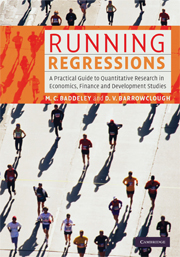 Running Regressions
Running Regressions How to use this book
Published online by Cambridge University Press: 05 June 2014
Summary
A minority of students relish the prospect of studying econometrics, as many are deterred perhaps by the technical jargon e.g. ‘autocorrelated disturbances’, ‘heteroscedasticity’ and ‘identification problems’. The aim of Running Regressions is to apply the practical aspects of elementary regression analysis to some interesting issues and without adopting an excessively esoteric and/or mathematical approach. Running Regressions shows that statistics and econometrics can be straightforward, useful and interesting.
A view to the real world
Running Regressions focuses on some topical, real-world issues. Econometric analyses may not seem to be the focus of articles in The Economist, the front page of the Financial Times, New York Times or in OXFAM's latest newsletter. But the professional application of econometric techniques underlies the insights expressed in the business press. Applied econometrics can earn you a living and win you arguments; it gives empirical ‘flesh’ to what might otherwise be dismissed as subjective opinion or abstract theory. Econometric analysis is used by policy-makers in deciding how much of the budget to devote to health or education, and/or what the tax rate should be. It is used by central bankers deciding whether to raise or lower interest rates. It is used by non-governmental organisations (NGOs) in illustrating the benefits of debt relief and/or how world trade rules can be designed better to advance the interests of developing countries. And it is used by hedge fund analysts to forecast stock market movements and currency fluctuations.
- Type
- Chapter
- Information
- Running RegressionsA Practical Guide to Quantitative Research in Economics, Finance and Development Studies, pp. 1 - 8Publisher: Cambridge University PressPrint publication year: 2009


